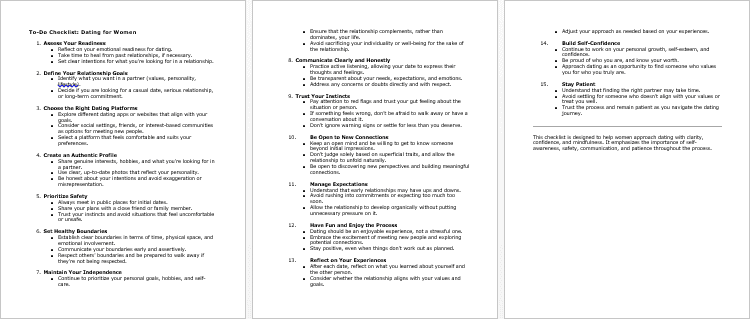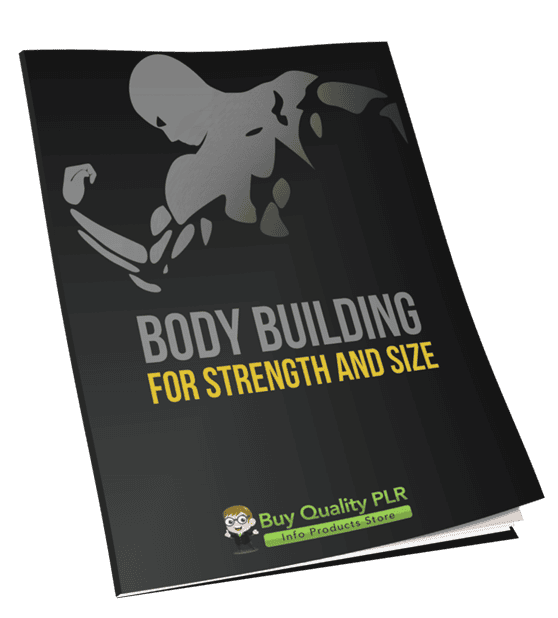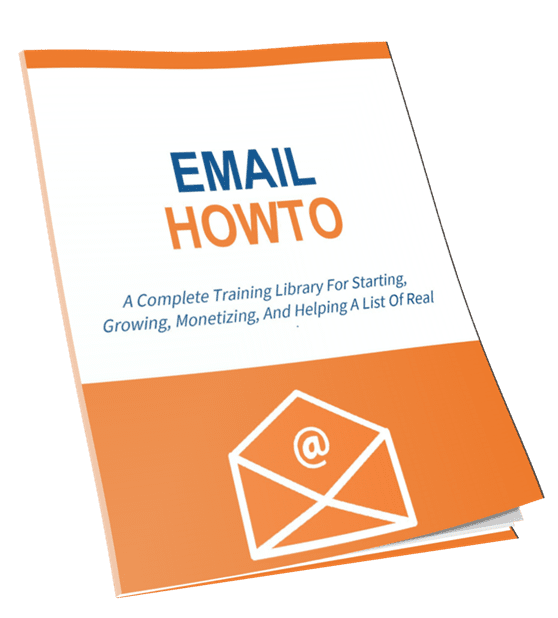
Dating for Women PLR Course 26k Words
in Dating PLR , Dating PLR Ebooks , PLR Checklists , PLR eBooks , PLR eCourses , PLR List Building Reports , Premium PLR , Premium PLR eBooks , Premium PLR Reports , Premium White Label Brandable PLR Coaching Courses , Private Label Rights Products , Relationships , Relationships PLR , Relationships PLR eBooksChoose Your Desired Option(s)
has been added to your cart!
have been added to your cart!
#datingforwomen #plrcourse #womensdatingtips #relationshipadviceplr #datingniche #plrcontent #datingguide #womenempowerment #loveadvice
Dating for Women PLR Course: Empower Yourself to Navigate the Dating World with Confidence and Clarity
Are you ready to empower women in their journey toward finding meaningful, authentic relationships? Presenting the Dating for Women PLR Course—a complete, step-by-step training program that helps women build confidence, develop healthy dating habits, and make informed choices when it comes to love and relationships. Whether you’re looking to sell this course or create additional content around it, this high-quality PLR product is designed to resonate with women seeking genuine connections and self-empowerment.
The Dating for Women PLR Course is perfect for anyone in the self-help or dating niche, offering comprehensive guidance that can be transformed into a product, membership site, or online course. With 24,364 words of actionable advice, this course will allow you to build a meaningful business while helping your customers confidently navigate the dating world.
Presenting…
Dating for Women PLR Course 26k Words
Course Overview: A Step-by-Step Guide to Dating Success
The Dating for Women PLR Course is broken down into five essential modules, each designed to address different aspects of dating. From understanding yourself to building lasting connections, this course provides valuable insights every woman needs to navigate the world of modern dating with ease.
Module 1: Understanding Yourself First
Before stepping into the world of dating, it’s essential to understand and value who you are. This module lays the foundation for empowered and successful dating by focusing on self-awareness.
- Step 1: Know Your Worth – Recognize your unique qualities and embrace them.
- Step 2: Clarify Your Values and Goals – Define what you truly want in a relationship.
- Step 3: Build Your Confidence – Boost your self-love and inner strength to become more attractive.
- Step 4: Set Realistic Expectations – Understand healthy expectations that foster fulfilling relationships.
Module 2: Navigating the Dating World
Now that you’re clear on who you are, it’s time to dive into the dating world. This module covers essential tips for navigating dating platforms and meetings in the real world.
- Step 1: Choose the Right Platforms – Whether it’s dating apps or social connections, find the best platforms for you.
- Step 2: Craft a Genuine Profile – Build an authentic, attractive dating profile that attracts the right people.
- Step 3: Stay Safe and Set Boundaries – Prioritize your safety and establish boundaries with confidence.
- Step 4: Keep an Open Mind – Learn to remain open to connections, even when they don’t meet all your initial expectations.
Module 3: Communication Skills for Effective Dating
Communication is key in any relationship. This module empowers women to effectively communicate, fostering stronger connections and clearer intentions.
- Step 1: Active Listening – Learn the art of listening with intention and creating meaningful conversations.
- Step 2: Be Honest and Transparent – Foster trust by expressing yourself honestly and openly.
- Step 3: Express Yourself Confidently – Communicate your desires, thoughts, and feelings with clarity.
- Step 4: Manage Expectations in Early Conversations – Avoid pressure and let the relationship develop naturally.
Module 4: Identifying Red Flags and Healthy Relationships
A key part of successful dating is knowing when to walk away from potential red flags. This module helps women identify the signs of a healthy and mutually respectful relationship.
- Step 1: Trust Your Instincts – Learn to trust your gut and recognize when something doesn’t feel right.
- Step 2: Look for Respect and Equality – Ensure that your relationships are built on mutual respect and equality.
- Step 3: Avoid Settling for Less Than You Deserve – Never settle for a relationship that doesn’t align with your standards.
- Step 4: Recognize Healthy Communication – Understand the importance of open and honest communication for a thriving relationship.
Module 5: Building a Lasting Connection
This final module helps women build long-lasting and meaningful connections by keeping things fresh, maintaining healthy communication, and embracing vulnerability.
- Step 1: Take Things at Your Own Pace – Don’t rush, let the connection develop naturally.
- Step 2: Keep the Spark Alive – Discover how to plan exciting dates and surprise each other.
- Step 3: Communicate Through Challenges – Learn how to manage challenges and conflicts effectively.
- Step 4: Embrace Vulnerability and Trust – Build deeper connections by allowing yourself to be open and vulnerable.
Bonus Materials: Additional Tools for Success
Along with the main course, we’ve included several bonus resources that enhance the learning experience and provide extra value for your customers:
- Dating for Women – Checklist (626 words): A practical checklist to keep your customers on track and help them implement what they’ve learned in the course.
- Dating for Women – FAQs (1,120 words): Answer common dating-related questions to reassure your customers and help them feel more confident.
- Dating for Women – Salespage (928 words): A professionally crafted sales page that you can use as-is or tweak to promote the course effectively.
How to Profit from the “Dating for Women” PLR Course
This PLR course offers several opportunities for monetization. Whether you want to sell it as a standalone product, use it as part of a larger membership site, or convert it into other formats, this course can help you build a profitable business. Here’s how you can profit:
1. Sell the Course as a Standalone Product
Sell the Dating for Women PLR Course directly on your website or through platforms like Etsy, Udemy, or Teachable for $47–$97. Customize the course to add more value and personalize it to your audience’s needs.
2. Break It Into Smaller Reports
You can break the course into smaller, digestible reports or mini-courses and sell them for $10–$20 each. This will make the course accessible to a wider audience and allow you to maximize revenue by selling individual modules.
3. Bundle with Other Related Content
Create bundles that include other PLR products, such as self-help guides, workbooks, or relationship tools, and sell them as a complete package for $97–$197.
4. Create a Membership Site
Use the PLR course as part of a membership site where you charge monthly fees for access to the course, bonus materials, and exclusive content. This model generates recurring income.
5. Convert to a Video or Audio Series
Turn the PLR course into video lessons or an audio series and sell it as a multimedia product for a higher price point.
6. Use as a Lead Magnet
Offer portions of the PLR course for free in exchange for email sign-ups. This will help you grow your audience and nurture leads, eventually upselling them to the full course or other products.
What You Can Do With This PLR Course:
Permissions – What Can You Do With These Materials?
- Sell the content with minor tweaks to make it your own.
- Break the content into smaller reports or modules to sell individually.
- Bundle it with other products to create a larger offering.
- Set up a membership site and charge recurring fees.
- Convert it into video or audio content and sell it for a premium.
- Use portions as lead magnets to build your email list.
- Create physical products, such as workbooks or guides.
Restrictions – What Can’t You Do With These Materials?
- You cannot pass on PLR rights to your customers.
- You cannot offer 100% affiliate commissions.
- You cannot give away the complete course for free; it must be sold or excerpted/edited to be offered for free.
- You cannot add the course to existing customer orders without requiring an additional purchase.
Start Empowering Women and Profiting Today with the Dating for Women PLR Course!
The Dating for Women PLR Course is your key to building a thriving business in the self-help and dating niches. With comprehensive, actionable content, a variety of monetization options, and valuable bonus materials, you’ll be well on your way to creating a profitable digital product that empowers women in their dating lives.
Get started today and help women find love and confidence while building your own profitable business!
has been added to your cart!
have been added to your cart!
Here A Sample of Dating for Women PLR Course
This course is designed to empower women with the knowledge, confidence, and skills to navigate the world of dating with clarity, excitement, and authenticity. Whether you’re new to dating or have some experience, this course will guide you step-by-step to make informed, empowering choices while building meaningful connections.
Module 1: Understanding Yourself First
Step 1: Know Your Worth
Overview:
Before you start your dating journey, one of the most important things you must do is recognize your own worth. This is not just about feeling good about yourself in the moment but understanding your intrinsic value as a person, the unique qualities you bring to the table, and why you deserve the kind of love and respect you seek. This step is foundational for setting the right expectations in dating, ensuring that you attract the right type of partner and enter relationships with confidence, authenticity, and a healthy sense of self.
1. Understand Your Unique Qualities
Every person is different, with their own set of talents, strengths, and experiences. These qualities make you who you are. Take time to reflect on what makes you special:
- Skills and Talents: Consider what you’re good at. Are you a great communicator, a creative thinker, or someone who’s incredibly organized? Recognizing and appreciating these skills not only boosts your confidence but also gives you insight into the qualities you can contribute to a relationship.
- Character Traits: Think about the personality traits that define you. Are you compassionate, loyal, empathetic, adventurous, or humorous? These traits play a major role in how you interact with others, and acknowledging them helps you build a strong sense of self-worth.
- Life Experiences: Your life journey, both the challenges and triumphs, has shaped you into the person you are today. Reflect on your achievements, the obstacles you’ve overcome, and the lessons you’ve learned. These experiences make you resilient and strong—qualities that are deeply valuable in any relationship.
Actionable Tip:
Write down at least five things you love about yourself, whether they are related to your personality, abilities, or accomplishments. This practice helps you focus on what makes you exceptional and worthy of a fulfilling relationship.
2. Embrace Your Imperfections
None of us are perfect, and that’s okay. Perfection doesn’t exist, and your imperfections are what make you authentic and human. It’s essential to embrace them rather than try to hide or reject them:
- Embrace Vulnerability: Accepting your flaws and imperfections helps build emotional resilience and trust. When you are comfortable with who you are, including your perceived flaws, it becomes easier to connect with others on a deeper level.
- Avoid the Trap of Comparison: In a world dominated by social media, it’s easy to fall into the trap of comparing yourself to others. This can lead to feelings of inadequacy. Instead, remind yourself that your journey is unique, and your value is not defined by others.
- Learn to Love Your Flaws: Everyone has quirks or traits they may not love, but these traits often make us more interesting and relatable. Embrace them! Realize that your imperfections can actually be a strength in a relationship, as they often make you more compassionate, empathetic, and real.
Actionable Tip:
Create a list of things that you feel self-conscious about and then counterbalance each of these with a strength or positive quality related to that trait. For example, if you feel insecure about being too shy, you can acknowledge that it makes you a great listener and more attuned to the needs of others.
3. Recognize Your Needs and Desires
Understanding your worth is not just about acknowledging your strengths and imperfections but also about recognizing what you need and desire in a relationship. Self-awareness is key to ensuring that you attract a partner who respects and values you for who you are:
- Know What You Want in a Partner: Take some time to reflect on the qualities that are important to you in a relationship. Do you need someone who is kind, intellectually stimulating, adventurous, or supportive? Understanding your needs and desires will help guide your choices in potential partners, ensuring that you do not settle for less than you deserve.
- Understand Your Relationship Goals: Are you looking for a long-term, committed relationship or something more casual? Defining your relationship goals will help you determine whether someone you meet aligns with what you’re looking for. Having clarity around your desires helps to set clear boundaries and expectations.
- Respect Your Boundaries: Knowing your worth also means knowing what you will and will not tolerate. Recognizing your boundaries is essential for self-respect. This could be anything from how you want to be treated in a relationship to how much time you’re willing to invest.
Actionable Tip:
Make a list of the non-negotiables you need in a relationship (such as trust, respect, and communication). Then, write down what you offer in return. This exercise helps create a clear vision of the type of relationship you want and deserve.
4. Cultivate Self-Love and Confidence
Self-love is the foundation of recognizing your worth. When you love yourself and believe in your value, you attract partners who treat you with the same level of respect and care. Here are some practical ways to build your self-love and confidence:
- Practice Affirmations: Start each day by affirming your worth and uniqueness. Statements like “I am enough,” “I deserve love,” or “I am worthy of a healthy, fulfilling relationship” can help reframe negative self-talk and build a stronger sense of self-esteem.
- Take Care of Your Body and Mind: Physical and mental well-being plays a huge role in how we perceive ourselves. Exercise regularly, eat nourishing foods, engage in activities that make you feel good, and get enough rest. When you feel good in your body and mind, your self-esteem naturally increases.
- Surround Yourself with Positive Influences: The people around you greatly impact your self-worth. Spend time with those who uplift and support you, and distance yourself from negative influences that might cause you to doubt your value.
Actionable Tip:
Create a self-care routine that involves both physical and mental practices. This might include activities like journaling, meditation, exercise, or even indulging in a hobby that makes you feel accomplished and happy.
5. Stop Seeking External Validation
While it’s natural to seek validation from others, especially in romantic contexts, true self-worth comes from within. Relying too heavily on external validation for your sense of value can lead to an unstable sense of self. Here’s how to break free from the need for constant external approval:
- Be Your Own Biggest Supporter: Trust yourself and your decisions. When you rely on your own internal compass, you are less likely to be swayed by others’ opinions. This inner strength builds a solid foundation for healthy relationships.
- Celebrate Your Own Achievements: Recognize and celebrate your accomplishments, whether big or small. Taking time to acknowledge your own efforts reinforces the idea that you don’t need external recognition to validate your worth.
- Shift Your Perspective on Rejection: Rejection in dating is not a reflection of your worth. It’s simply a mismatch, and that’s okay. When you realize that you are valuable regardless of external approval, you will find it easier to handle rejection gracefully and move forward with confidence.
Actionable Tip:
Next time you receive a compliment or praise, thank the person and then take a moment to reflect on why you deserve it. This practice reinforces your belief in your intrinsic worth and helps build your confidence.
Final Thoughts
Knowing your worth is not just a concept but a continuous practice. As you embark on your dating journey, remember that understanding your value allows you to navigate relationships with clarity, confidence, and a healthy sense of self. When you embrace your unique qualities, acknowledge your imperfections, and stand firm in your desires, you are in the best position to attract a partner who appreciates and cherishes you for exactly who you are. This foundation of self-awareness will guide you through your dating journey, helping you build relationships that are not only fulfilling but also aligned with your authentic self.
Step 2: Clarify Your Values and Goals
Overview:
When you embark on your dating journey, it’s vital to understand what you truly want and need from a relationship. While attraction and chemistry are important, they are only part of the equation. Clarifying your values and goals provides you with a roadmap for finding a compatible partner. It ensures that your relationship aligns with your deepest beliefs, desires, and expectations, which ultimately lays the foundation for a meaningful and fulfilling connection. In this step, we’ll explore how to define what matters most to you in a relationship and why doing so is crucial for making informed and authentic dating choices.
1. Understand the Core Values That Guide Your Life
Every individual has core values—fundamental beliefs that influence your decisions, behavior, and relationships. Understanding these values is essential to attracting someone who shares your worldview and can align with your life journey.
- Identify Your Personal Values:
Begin by taking a moment to reflect on your life and what matters most to you. Core values could include things like honesty, loyalty, integrity, kindness, and compassion. These values are the non-negotiable principles that guide how you interact with others and make decisions in all aspects of life, including relationships. Make a list of your top 5 to 10 values. - Assess Your Deal Breakers:
Just as it’s important to know what you want in a partner, you must also identify what you absolutely cannot tolerate in a relationship. These are your “deal breakers.” For example, if respect and honesty are at the top of your values list, a relationship without these qualities is not likely to succeed. Take time to reflect on your past relationships and what made them work or fail—often, the values that were missing are the ones that led to dissatisfaction. - Align Your Actions with Your Values:
To fully embrace your values, ensure that your actions reflect them. For example, if one of your values is adventure, but you always stay within your comfort zone, it might be time to re-evaluate how you’re living. In dating, make sure the decisions you make align with your values, such as being honest and respectful from the start.
Actionable Tip:
Take a piece of paper and divide it into two sections. In the first section, list the values that are most important to you in a relationship. In the second section, write down any past experiences where these values were violated, and how it made you feel. This exercise will help you clarify the non-negotiables in your dating life.
2. Define Your Relationship Goals
Understanding what you want from a relationship is essential in ensuring you’re not only dating for fun but are also aligning with someone who shares your vision for the future. Your relationship goals will guide your actions and decisions when it comes to finding a suitable partner.
- Long-Term vs. Short-Term Goals:
Reflect on whether you are seeking a long-term commitment, such as marriage or a serious partnership, or something more casual. Knowing the type of relationship you want helps you set realistic expectations and avoid mismatched intentions. If you’re seeking something casual, communicating that early on can help avoid misunderstandings. However, if you want a lifelong partner, prioritize partners who share that vision. - Consider Lifestyle Compatibility:
In addition to commitment, think about what kind of lifestyle you want. Do you envision a relationship centered around travel, family, or career growth? Do you want to share a home and build a life together, or are you more focused on your independence and personal growth? Understanding what you want in terms of lifestyle will help you find someone whose goals align with yours. - Career and Personal Growth:
Consider how important career goals or personal growth are to you in a relationship. Do you want a partner who values personal development, or is it more important for them to support your professional ambitions? This clarity helps to choose a partner who not only fits your lifestyle but also supports your long-term personal goals. - Family and Children:
A significant part of relationship goals involves family planning, including whether you want to have children or not, and if so, when. Are you looking for someone who shares your view on parenting? Do you have a particular approach to family dynamics? Clarifying these aspects early can help guide your dating choices.
Actionable Tip:
Write down your relationship goals in a journal. List them in order of importance (long-term commitment, family, travel, career support, etc.). This document will act as a guide to evaluate potential partners and will help you stay focused on what truly matters to you.
3. Evaluate Compatibility with Your Values and Goals
Once you have a clear understanding of your values and goals, it’s time to think about compatibility with potential partners. Compatibility goes beyond shared interests and attraction; it’s about alignment with your deeper values and long-term objectives.
- Assess Emotional Compatibility:
Emotional compatibility is about understanding and connecting on an emotional level. Does the person you’re dating respect your emotions, and can they communicate openly? Emotional compatibility also means being able to handle conflicts in a healthy way, with empathy and understanding. Evaluate if a potential partner’s emotional responses and attitudes resonate with your values. - Assess Value Compatibility:
Review how well your values align with those of the person you’re dating. For instance, if honesty is a core value for you, does the other person show transparency in their actions and words? Do you both share similar views on things like loyalty, respect, personal space, or family dynamics? - Assess Long-Term Vision Compatibility:
Consider if your long-term goals align. Are your aspirations in life compatible? For instance, if you are career-focused and your partner has a more family-oriented goal, it might be challenging to balance both unless there is open communication and compromise.
Actionable Tip:
Ask yourself: “Do I feel like my values are respected and appreciated in this relationship?” If the answer is no, it’s important to re-evaluate the compatibility. It’s not about perfection but rather alignment with the most essential aspects of your life.
4. Prioritize Your Values and Goals in Dating Decisions
Now that you’ve identified and understood your values and goals, the next step is to prioritize them in your dating decisions. This means making choices that align with your vision for the future, even if it means letting go of someone who doesn’t fit the criteria.
- Be Selective in Your Choices:
In the realm of dating, it’s tempting to rush into things, especially when the chemistry feels great. However, prioritizing your values and goals means being selective about who you invest your time and energy in. If someone doesn’t share your long-term vision or doesn’t align with your core values, it may be better to walk away early to avoid wasted time or emotional energy. - Communicate Your Values and Goals Clearly:
It’s important to communicate your values and goals clearly to potential partners. This helps avoid confusion and ensures you’re both on the same page. If your values include loyalty and honesty, make that clear early on. Similarly, if your goal is to have children or build a career together, it’s essential to express that. - Stay True to Your Non-Negotiables:
When faced with challenges or doubts, remind yourself of your core values and goals. Are you compromising too much on something that’s important to you? Staying true to your non-negotiables ensures you don’t settle for less than what you deserve. In the long run, sticking to these values will lead to a more fulfilling and meaningful relationship.
Actionable Tip:
Create a “relationship checklist” with your non-negotiables (values and goals). When evaluating someone you’re dating, compare how well they align with this checklist. This practice ensures you’re staying true to your vision while making decisions that reflect your long-term desires.
Final Thoughts
Clarifying your values and goals is a critical step in creating a healthy, sustainable relationship. When you take the time to reflect on what matters most to you—whether it’s respect, loyalty, shared interests, or long-term compatibility—you are setting the stage for finding a partner who truly aligns with your vision. This process is not about finding someone who’s perfect, but someone who complements and supports your values, goals, and overall vision for the future. By staying true to what you want, you’ll ensure that your dating choices reflect the life and relationship you truly deserve.
Step 3: Build Your Confidence
Overview:
Confidence is an essential element of successful dating. When you have strong self-assurance, you present yourself authentically, which is attractive to potential partners. Confidence allows you to assert your worth, establish healthy boundaries, and communicate clearly, all of which are vital in building a meaningful connection. In this step, we’ll explore how to develop and strengthen your confidence, how to practice self-love, and how these elements contribute to building healthy, fulfilling relationships.
Confidence isn’t something that happens overnight; it’s a continuous journey. By understanding the importance of confidence and implementing daily practices to nurture it, you will feel more secure in who you are and what you bring to the table, which will ultimately enhance your dating life.
1. Cultivate a Positive Self-Image
Building confidence begins with having a healthy self-image. How you view yourself shapes your ability to approach dating with positivity and assurance. It is important to understand that your value is inherent, and it is not dependent on external validation or anyone else’s approval.
- Practice Self-Acceptance:
Start by accepting yourself fully, including your strengths and flaws. Nobody is perfect, and your imperfections are part of what makes you unique. Instead of focusing on what you perceive as weaknesses, shift your attention to your strengths. Think about what makes you special and how your unique qualities add value to your relationships. This self-acceptance helps to reduce self-doubt and creates a foundation for confidence. - Affirm Your Worth:
Each day, make a conscious effort to affirm your worth. Speak positive affirmations aloud, such as “I am deserving of love and respect,” “I am a valuable partner,” or “I have everything I need within me to attract the right partner.” These affirmations reinforce your self-worth and help reprogram your mindset to see yourself positively. The more you affirm yourself, the more naturally it becomes part of your everyday thinking. - Embrace Your Uniqueness:
Understand that there is no one else like you in the world. Your personality, talents, experiences, and quirks are all things that make you who you are. Embrace these aspects, and stop comparing yourself to others. Confidence thrives when you focus on your own path, not someone else’s. In dating, this means that you attract the right person by being authentically yourself.
Actionable Tip:
Write a list of your top five strengths or qualities that you love about yourself. Every morning, take a moment to read this list aloud and affirm them. Over time, this practice will help shift your mindset toward greater self-appreciation and confidence.
2. Practice Self-Love and Self-Care
Self-love is the cornerstone of building confidence. You can’t rely on someone else to make you feel worthy or validated—this must come from within. When you take care of yourself physically, emotionally, and mentally, you send a message to yourself that you are worth the effort and care.
- Engage in Self-Care Rituals:
Self-care is about nurturing your well-being in every way possible. This can include activities such as regular exercise, eating nutritious meals, getting enough sleep, and taking time to relax. Self-care practices help you feel good about yourself and can dramatically improve your self-esteem. Moreover, when you feel physically well and rested, it naturally boosts your confidence. - Prioritize Your Emotional Health:
Emotional self-care is just as important as physical care. Engage in activities that help you relax and recharge, such as meditation, journaling, or spending time with loved ones who uplift you. It’s important to check in with your emotions and take steps to manage stress, anxiety, or negative feelings. Practicing emotional care allows you to approach dating from a place of calmness and mental clarity, which will also help you make more informed and confident choices. - Set Time for Activities You Love:
When you take the time to do things that bring you joy, you remind yourself of your value. Whether it’s pursuing a hobby, traveling, or just having time for yourself, these moments contribute to your overall well-being. Engaging in activities that make you feel happy boosts your self-confidence and reinforces the idea that you are worthy of joy and love.
Actionable Tip:
Set aside at least one hour a day for yourself. Use this time to engage in a self-care activity that nurtures you, whether it’s a relaxing bath, a walk in nature, or reading a book you enjoy. The more you practice self-care, the more confident and grounded you’ll feel.
3. Embrace Body Positivity
Confidence is also about feeling comfortable in your own skin. Body image plays a significant role in how we view ourselves, and embracing body positivity is key to cultivating confidence. Learning to love and appreciate your body, no matter its shape or size, helps you stand tall in any dating situation.
- Focus on What Your Body Does, Not Just How It Looks:
Instead of solely focusing on physical appearance, shift your attention to what your body allows you to do. For example, your body may help you move through the world with strength, agility, and grace. It may allow you to engage in activities that you love, such as dancing, running, or playing sports. Appreciating your body for its functionality, rather than just appearance, can improve your body image and overall confidence. - Dress for Confidence:
The way you dress can significantly impact how you feel about yourself. Choose clothing that makes you feel confident, comfortable, and authentic. When you wear clothes that fit well and reflect your personality, you are more likely to feel positive and empowered. Confidence can come from feeling comfortable in your attire and knowing that your appearance reflects your inner self. - Stop Comparing Yourself to Others:
Avoid comparing your body to others. Every person is unique, and everyone has their own set of strengths and challenges. Social media can often fuel body image issues, but remind yourself that real beauty comes from within. The more you embrace your own body, the more others will see your confidence shine.
Actionable Tip:
Create a body-positive mantra. For example, say: “I love and appreciate my body for all it does for me.” Say this mantra whenever you feel insecure about your appearance. The more you practice body positivity, the easier it becomes to accept and love yourself just as you are.
4. Set Healthy Boundaries
Confidence is directly tied to the ability to set and maintain healthy boundaries. Boundaries are essential in dating because they protect your emotional well-being and ensure that your needs and desires are respected. Being able to confidently express your boundaries means you value yourself enough to create space for the things that matter to you.
- Understand What Your Boundaries Are:
Start by identifying the things that are most important to you in a relationship. These could include personal space, respect for your time, communication preferences, or physical touch. Knowing your limits is essential for setting boundaries. Reflect on past experiences to recognize any behaviors you are no longer willing to tolerate in a relationship. - Communicate Your Boundaries Clearly:
Once you’ve identified your boundaries, communicate them clearly and assertively. This is not about being rigid or demanding but rather expressing your needs in a way that ensures both you and your partner feel comfortable. For example, if you need personal time to recharge, let your partner know that you value alone time and need space to refresh. Healthy communication of boundaries is key to any successful relationship. - Respect the Boundaries of Others:
Just as it’s important to set your own boundaries, it’s equally important to respect the boundaries of others. In dating, this means honoring your partner’s personal space, preferences, and limits. Mutual respect for each other’s boundaries fosters trust and deepens your connection. - Don’t Be Afraid to Say “No”:
Sometimes, confidence means saying “no” when something doesn’t align with your values or comfort zone. If a situation or behavior makes you uncomfortable, it’s okay to assert yourself and walk away. By saying no, you protect your well-being and set the tone for respectful interactions.
Actionable Tip:
Write down your personal boundaries in a journal. This might include emotional boundaries, physical boundaries, and time boundaries. Revisit this list periodically and remind yourself of the importance of maintaining them in your relationships. Confidence grows when you honor your own needs.
5. Practice Effective Communication
Confidence in dating is also about being able to communicate openly and effectively. Clear communication helps you express your needs, share your feelings, and set expectations with potential partners.
- Be Direct and Honest:
Confidence allows you to speak directly and honestly about what you want or don’t want in a relationship. Avoid playing games or being passive-aggressive. Clear and open communication builds trust and reduces misunderstandings. If something bothers you, don’t be afraid to speak up in a respectful and straightforward manner. - Listen Actively:
Confidence isn’t just about speaking; it’s also about listening. Active listening helps you understand the other person’s perspective and build a deeper connection. Be present in the conversation, ask thoughtful questions, and show genuine interest in your partner’s thoughts and feelings. - Address Conflicts with Calmness:
Confident people don’t shy away from difficult conversations or conflicts. When conflicts arise, handle them with poise. Stay calm, listen to the other person’s point of view, and express your concerns respectfully. This ability to manage conflict effectively strengthens relationships.
Actionable Tip:
Practice communication skills with friends or family. Role-play dating scenarios where you might need to express your boundaries, desires, or feelings. The more you practice, the more natural confident communication will feel.
Final Thoughts
Building confidence is a transformative process that positively impacts every area of your life, especially your dating experience. When you feel confident in yourself, you radiate a magnetic energy that attracts others. Confidence is not about being perfect, but about accepting who you are, embracing your uniqueness, and approaching dating from a place of self-respect. As you work through this step, remember that confidence is something that grows with time, consistency, and self-compassion. Keep practicing and nurturing these habits, and you will notice profound shifts in your dating life and your relationships.
Step 4: Set Realistic Expectations
Overview:
Setting realistic expectations in dating is a crucial step towards building meaningful and lasting relationships. It is easy to get swept away by idealized notions of what the perfect partner should look like or how the relationship should unfold. However, when our expectations are too high or unrealistic, it can lead to disappointment, frustration, or even the breakdown of the relationship. Instead, it is vital to create expectations that are healthy, achievable, and aligned with your values, needs, and the reality of relationships.
In this step, we will explore how to set balanced, realistic expectations for both yourself and your partner. By recognizing the difference between idealism and reality, you will set the foundation for a fulfilling and lasting connection. Understanding that relationships take work, compromise, and understanding helps ensure that you find a partner who can meet you halfway, making the journey of dating more enjoyable and grounded.
1. Understand the Difference Between Idealism and Realism
It’s easy to envision an ideal partner and a perfect relationship in your mind. You may have dreamed of someone who fits a very specific mold — tall, kind, successful, emotionally available, adventurous, and passionate. While dreaming about these qualities is natural, it’s essential to recognize that no one is perfect, and perfection is not a realistic expectation.
- Acknowledge Imperfections in Others and Yourself:
We are all flawed, and that includes both you and potential partners. Perfection is an illusion. When you acknowledge that both you and your partner will have imperfections, it helps to lower unrealistic expectations and creates space for acceptance and growth. Relationships are about working together through challenges and celebrating strengths, not about finding someone who ticks every single box. - Recognize Human Limitations:
No matter how well-intentioned, everyone will have areas of weakness or limitations. For example, someone may be wonderful in terms of their career or family life but struggle with expressing emotions. Similarly, you may have personal growth areas, such as time management or dealing with stress, that require attention. Setting realistic expectations includes understanding and accepting these limitations without expecting your partner to be flawless. - Let Go of “Fairytale” Narratives:
A common challenge in dating is the expectation that your relationship should be like a fairytale: smooth, magical, and free from conflict. While love and connection are wonderful experiences, every relationship requires work, compromise, and time to grow. Setting realistic expectations involves recognizing that a relationship may not always feel “perfect,” but it can still be fulfilling and meaningful when both partners are committed to making it work.
Actionable Tip:
Write down some characteristics you value most in a partner. Then, make a list of the qualities or traits you could realistically work with or compromise on. This will help you separate what is absolutely non-negotiable from what could be flexible.
2. Set Expectations for Communication
Communication is the foundation of any strong relationship. However, having unrealistic expectations about how often or how deeply a partner should communicate can lead to misunderstandings and unmet needs. For example, expecting constant text messages, immediate replies, or long, in-depth conversations at all hours can create unnecessary pressure and strain on the relationship.
- Respect Personal Space:
It’s essential to set expectations about communication that respect both your and your partner’s individual needs. Some people are naturally more introverted and need time alone to recharge, while others might be more extroverted and thrive on frequent social interaction. Understanding these differences is vital for maintaining balance in the relationship. Rather than setting unrealistic expectations for constant communication, allow room for personal space and individual time. - Discuss Communication Preferences Early On:
From the beginning of your relationship, have an open discussion about how often you both expect to communicate. Are you someone who likes to check in multiple times a day, or do you prefer fewer, deeper conversations? By being upfront about these preferences, you can avoid any confusion or unmet expectations down the road. - Understand That Conflict Resolution Takes Time:
Setting realistic expectations in communication also includes recognizing that conflicts will arise, and resolving them requires time, patience, and effort. Expecting smooth, conflict-free communication in every situation is unrealistic. Instead, set the expectation that you and your partner will work through disagreements with respect, openness, and a willingness to compromise.
Actionable Tip:
Create a “communication agreement” with your partner. Discuss your preferences regarding texting, calls, and face-to-face communication. Agree on how you’ll address miscommunications or arguments, and ensure both partners feel heard and valued.
3. Define Your Relationship Goals
A common pitfall in dating is the assumption that both partners are looking for the same thing without openly discussing it. Clarifying what you want out of a relationship will ensure that you and your partner are aligned in your desires and goals.
- Understand Your Needs and Desires:
Take time to reflect on what you want in a relationship. Are you looking for something casual or long-term? Do you want to get married eventually, or are you focused on personal growth and exploration? Understanding your own relationship goals is crucial in setting realistic expectations. If your goal is to eventually settle down and start a family, it’s important to find a partner who shares that vision, rather than someone who is looking for a short-term fling. - Communicate Your Relationship Goals:
Once you’ve defined your goals, have an open conversation with your partner about what you both want from the relationship. This is especially important early on. For example, if you’re looking for long-term commitment, let your partner know. If your partner’s goals differ, it’s better to know early on than to invest time in a relationship that might not align with your needs. - Adjust Expectations Based on the Stage of the Relationship:
It’s important to be realistic about where you are in the relationship. Early on, the focus should be on getting to know each other and building trust. Expecting intense commitment, exclusivity, or deep emotional connections right away can set the relationship up for disappointment. Instead, be clear about what stage you’re at, and adjust your expectations accordingly.
Actionable Tip:
Make a list of your long-term relationship goals and ask your partner about theirs. Discuss any areas where your visions align or differ. Having clarity early on will help you both understand if you’re on the same page.
4. Practice Patience and Flexibility
In dating, not everything will go according to plan, and that’s okay. Setting realistic expectations means accepting that relationships take time and that things won’t always unfold exactly as you imagined. This includes being patient with your partner’s growth, progress, and the natural evolution of the relationship.
- Embrace the Unpredictability of Dating:
Dating isn’t always a linear process, and relationships can grow and develop in unexpected ways. There may be twists and turns, moments of uncertainty, or times when you question things. Rather than expecting everything to be perfect or always moving forward, practice patience and allow things to unfold naturally. - Be Willing to Adapt to Changing Circumstances:
Real life can throw curveballs, such as changes in work schedules, family dynamics, or unexpected challenges. Setting realistic expectations means being flexible and understanding when your partner’s circumstances change, and being willing to adjust your expectations accordingly. A relationship should be able to weather these changes and adapt as needed. - Understand That Growth Takes Time:
Both you and your partner will evolve as individuals throughout your relationship. It’s unrealistic to expect constant perfection or immediate growth. Be patient with the process and allow room for both partners to learn, change, and grow. Celebrate progress rather than focusing on perfection.
Actionable Tip:
When faced with challenges, take a step back and assess the situation objectively. Ask yourself if your expectations are based on reality or if you need to adjust them. Communicating openly about frustrations and expectations helps reduce tension and fosters mutual understanding.
5. Create Healthy Boundaries in Expectations
Boundaries are key to managing realistic expectations. Without boundaries, it’s easy to become overwhelmed or frustrated when expectations are not met. Setting healthy boundaries in your expectations ensures that both partners feel respected, valued, and understood.
- Set Boundaries Regarding Time and Space:
Relationships require time and attention, but so does your individual life. Setting boundaries around personal time, social commitments, and space for self-care is vital for maintaining balance. It’s important to recognize that while your partner should be a priority, you are also entitled to have time for yourself and for other important aspects of your life. - Respect the Boundaries of Your Partner:
Just as you have your own boundaries, so does your partner. Recognize and respect your partner’s need for space, time, and personal growth. Setting boundaries means understanding each other’s needs without overstepping or imposing unrealistic expectations. - Maintain Flexibility in Boundaries:
Boundaries are not rigid. As you grow in your relationship, certain expectations may shift or change. Be open to revisiting and adjusting boundaries as needed, always with mutual respect and understanding.
Actionable Tip:
Sit down with your partner and discuss what boundaries each of you has in the relationship. This may include things like alone time, communication frequency, or how to manage conflicts. Establishing clear boundaries from the start helps prevent misunderstandings and ensures both partners feel secure.
Final Thoughts
Setting realistic expectations is one of the most important aspects of building a healthy, successful relationship. By understanding that no one is perfect, communicating openly, defining relationship goals, practicing patience, and respecting boundaries, you create the foundation for a strong connection. Remember, relationships require effort, understanding, and flexibility. When you approach dating with realistic expectations, you’re setting yourself up for greater happiness, fulfillment, and a deeper connection with your partner.
We’re also giving these extra bonuses
Dating for Women – Checklist

Dating for Women – FAQs

Dating for Women – Salespage Content

Package Details:
Word Count: 24 364 Words
Number of Pages: 90
Dating for Women – Bonus Content
Checklist
Word Count: 626 words
FAQs
Word Count: 1120 words
Salespage Content
Word Count: 928 words
Total Word Count: 27 038 Words
Your PLR License Terms
PERMISSIONS: What Can You Do With These Materials?
Sell the content basically as it is (with some minor tweaks to make it “yours”).
If you are going to claim copyright to anything created with this content, then you must substantially change at 75% of the content to distinguish yourself from other licensees.
Break up the content into small portions to sell as individual reports for $10-$20 each.
Bundle the content with other existing content to create larger products for $47-$97 each.
Setup your own membership site with the content and generate monthly residual payments!
Take the content and convert it into a multiple-week “eclass” that you charge $297-$497 to access!
Use the content to create a “physical” product that you sell for premium prices!
Convert it to audios, videos, membership site content and more.
Excerpt and / or edit portions of the content to give away for free as blog posts, reports, etc. to use as lead magnets, incentives and more!
Create your own original product from it, set it up at a site and “flip” the site for megabucks!
RESTRICTIONS: What Can’t You Do With These Materials?
To protect the value of these products, you may not pass on the rights to your customers. This means that your customers may not have PLR rights or reprint / resell rights passed on to them.
You may not pass on any kind of licensing (PLR, reprint / resell, etc.) to ANY offer created from ANY PORTION OF this content that would allow additional people to sell or give away any portion of the content contained in this package.
You may not offer 100% commission to affiliates selling your version / copy of this product. The maximum affiliate commission you may pay out for offers created that include parts of this content is 75%.
You are not permitted to give the complete materials away in their current state for free – they must be sold. They must be excerpted and / or edited to be given away, unless otherwise noted. Example: You ARE permitted to excerpt portions of content for blog posts, lead magnets, etc.
You may not add this content to any part of an existing customer order that would not require them to make an additional purchase. (IE You cannot add it to a package, membership site, etc. that customers have ALREADY paid for.)
Share Now!












